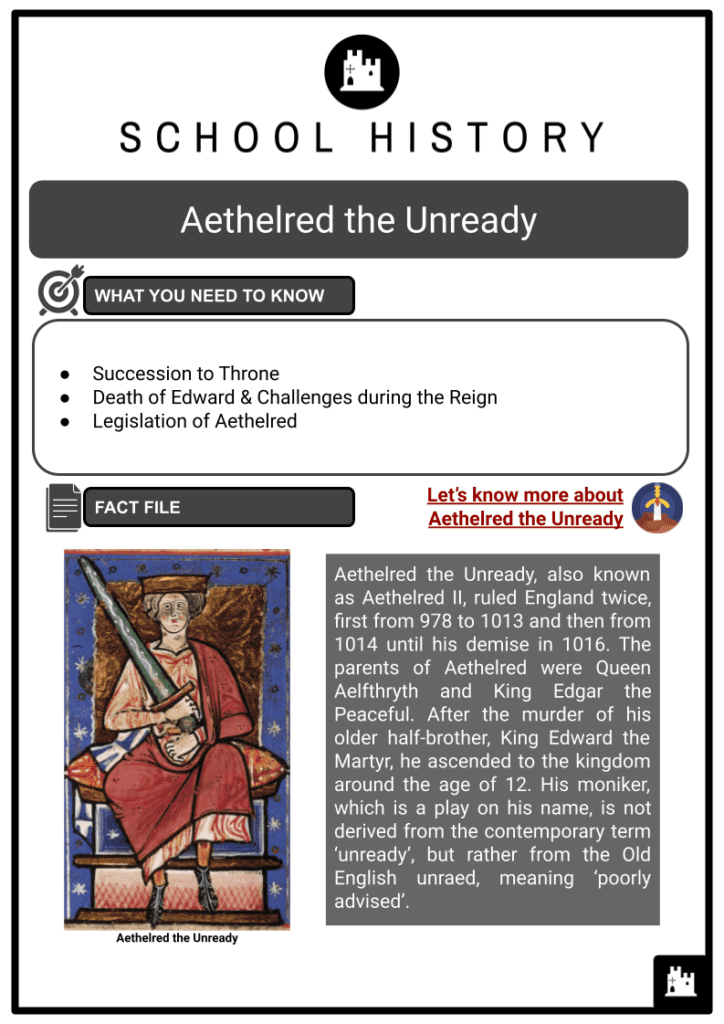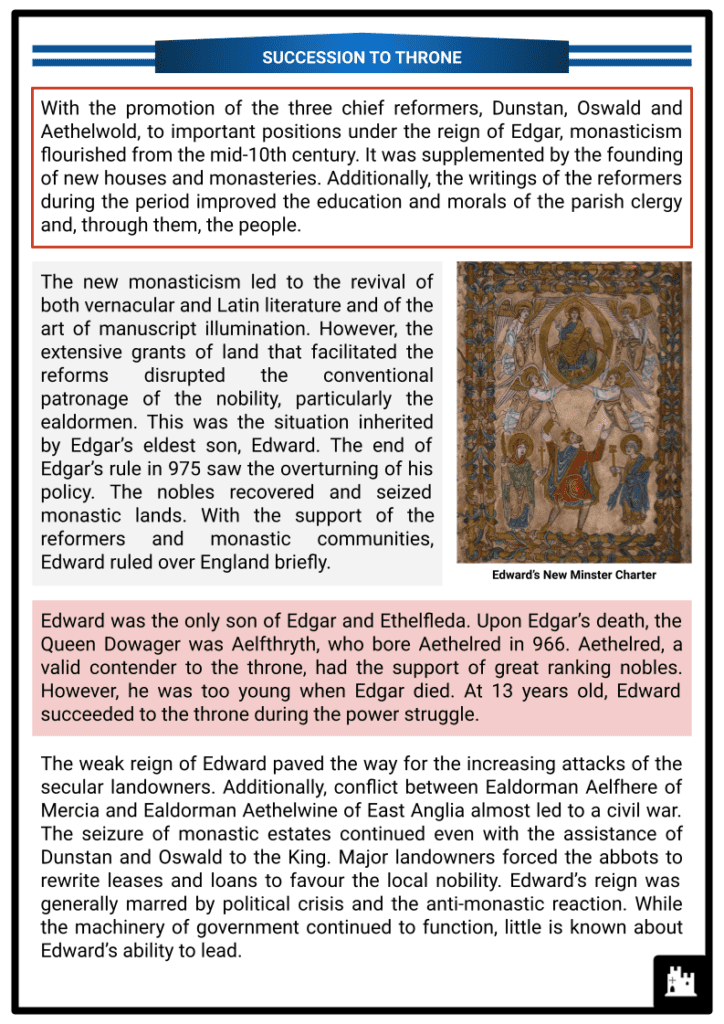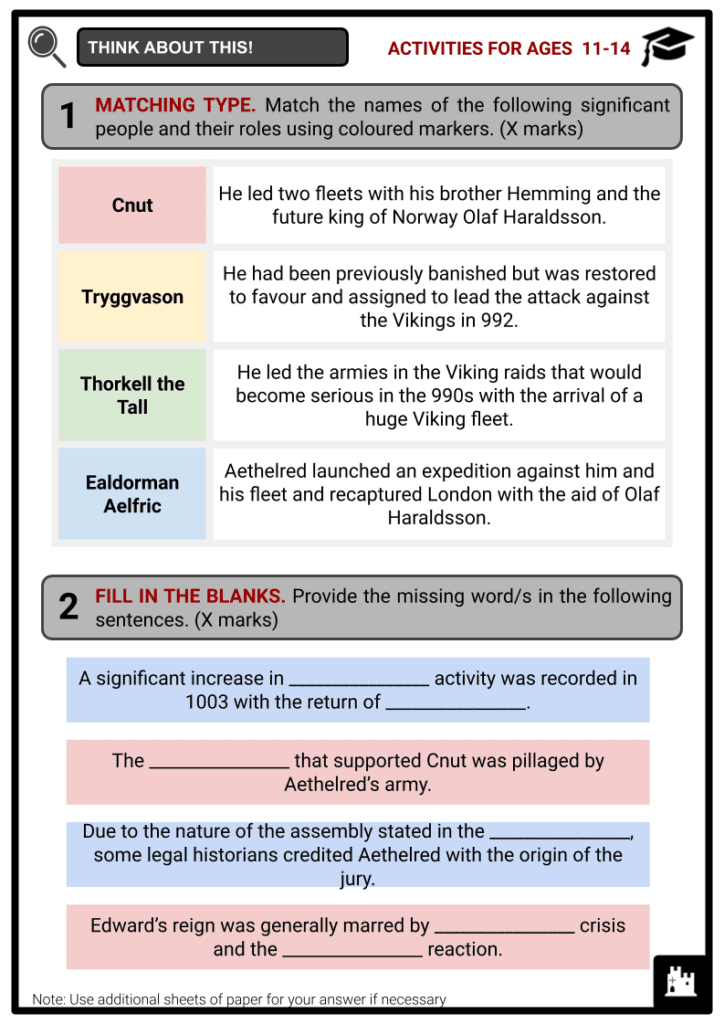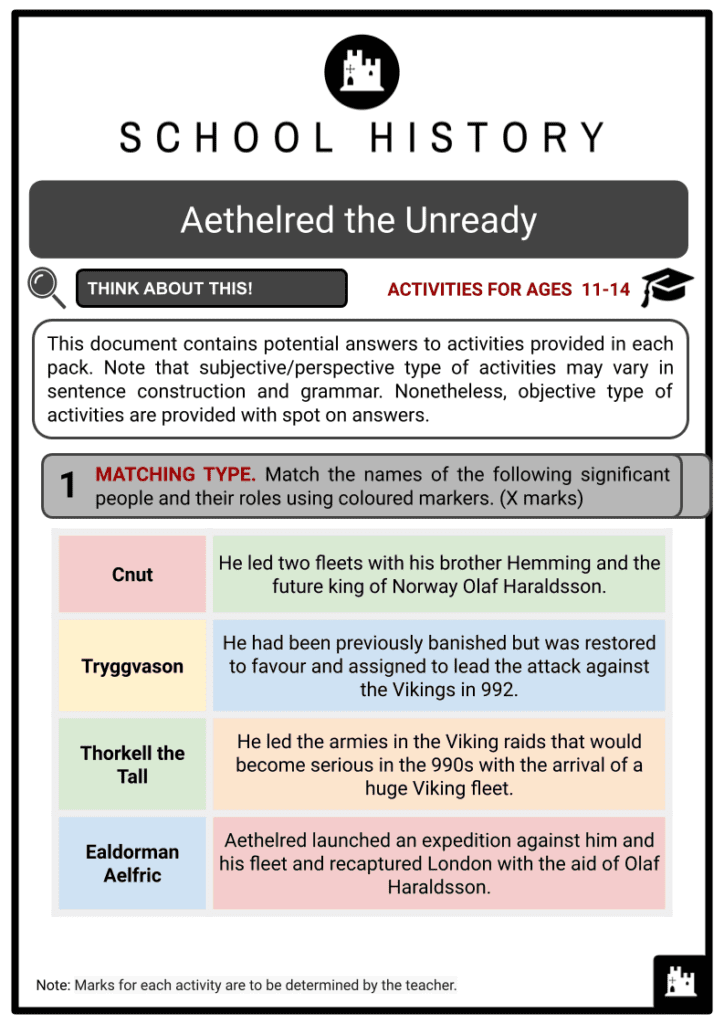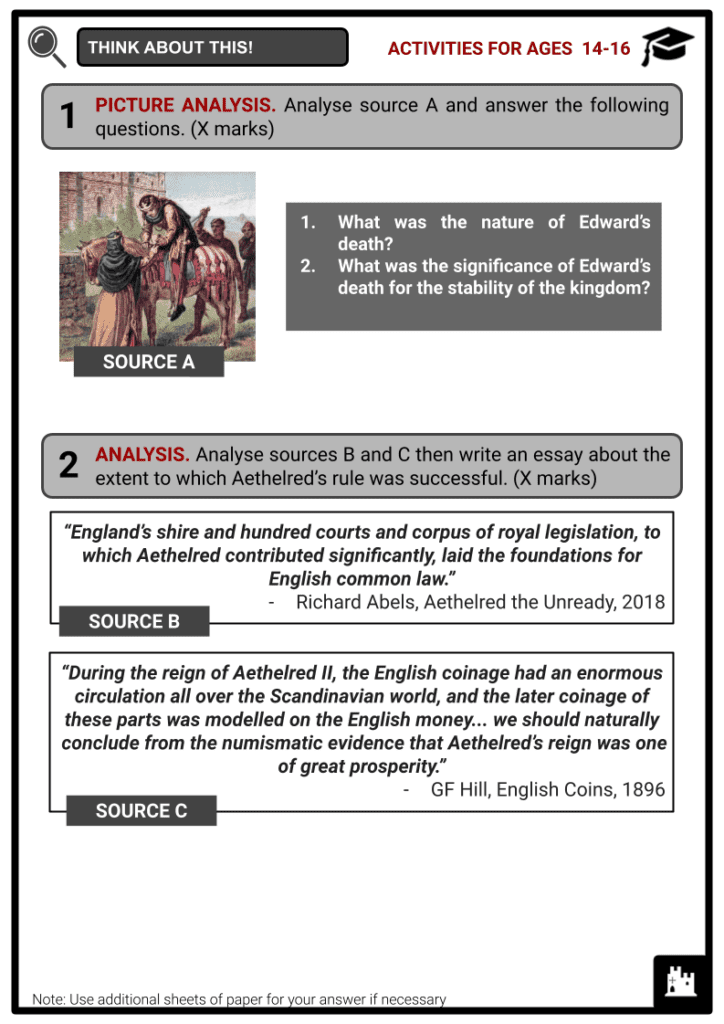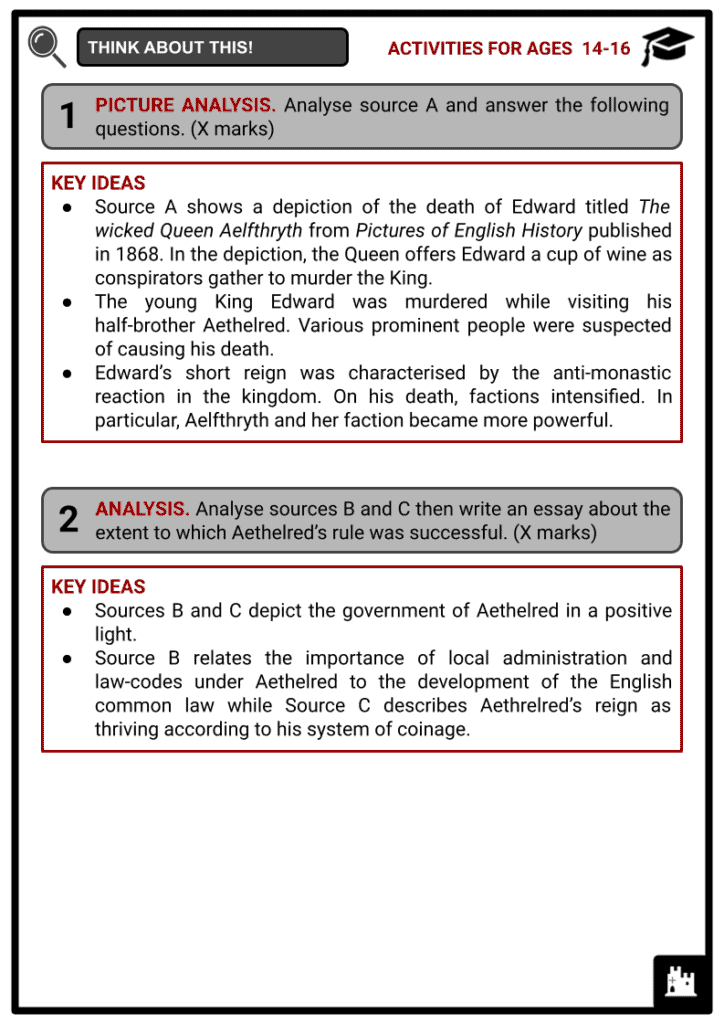Aethelred the Unready Worksheets
Do you want to save dozens of hours in time? Get your evenings and weekends back? Be able to teach about Aethelred the Unready to your students?
Our worksheet bundle includes a fact file and printable worksheets and student activities. Perfect for both the classroom and homeschooling!
Summary
- Succession to Throne
- Death of Edward & Challenges during the Reign
- Legislation of Aethelred
Key Facts And Information
Let’s know more about Aethelred the Unready!

Aethelred the Unready, also known as Aethelred II, ruled England twice, first from 978 to 1013 and then from 1014 until his demise in 1016. The parents of Aethelred were Queen Aelfthryth and King Edgar the Peaceful. After the murder of his older half-brother, King Edward the Martyr, he ascended to the kingdom around the age of 12. His moniker, which is a play on his name, is not derived from the contemporary term ‘unready’, but rather from the Old English unraed, meaning ‘poorly advised’.
SUCCESSION TO THRONE
- With the promotion of the three chief reformers, Dunstan, Oswald and Aethelwold, to important positions under the reign of Edgar, monasticism flourished from the mid-10th century. It was supplemented by the founding of new houses and monasteries. Additionally, the writings of the reformers during the period improved the education and morals of the parish clergy and, through them, the people.
- The new monasticism led to the revival of both vernacular and Latin literature and of the art of manuscript illumination. However, the extensive grants of land that facilitated the reforms disrupted the conventional patronage of the nobility, particularly the ealdormen. This was the situation inherited by Edgar’s eldest son, Edward. The end of Edgar’s rule in 975 saw the overturning of his policy. The nobles recovered and seized monastic lands. With the support of the reformers and monastic communities, Edward ruled over England briefly.
- Edward was the only son of Edgar and Ethelfleda. Upon Edgar’s death, the Queen Dowager was Aelfthryth, who bore Aethelred in 966. Aethelred, a valid contender to the throne, had the support of great ranking nobles. However, he was too young when Edgar died. At 13 years old, Edward succeeded to the throne during the power struggle.
- The weak reign of Edward paved the way for the increasing attacks of the secular landowners. Additionally, conflict between Ealdorman Aelfhere of Mercia and Ealdorman Aethelwine of East Anglia almost led to a civil war. The seizure of monastic estates continued even with the assistance of Dunstan and Oswald to the King. Major landowners forced the abbots to rewrite leases and loans to favour the local nobility. Edward’s reign was generally marred by political crisis and the anti-monastic reaction. While the machinery of government continued to function, little is known about Edward’s ability to lead.
DEATH OF EDWARD & CHALLENGES DURING THE REIGN
- Edward’s reign would come to a close when he visited his half-brother Aethelred at Corfe Castle. Accompanied by a small group of men while waiting to be allowed entry at the gates of the castle, Edward was assassinated in the evening of 18 March 978.
- The Chronicle failed to mention the men behind the young king’s murder, but theories have been proposed regarding the murder:
- Nobles in Aethelred’s service killed Edward.
- Aelfthryth and her faction orchestrated the assassination.
- Ealdorman Aelfhere of Mercia killed the King to preserve his own influence.
- He came to be known as Edward the Martyr due to the nature of his death. While he was never canonised, his status as a saint was promoted by numerous miracles believed to have occurred at his tomb. The murder of Edward the Martyr was followed by the succession of Aethelred to the throne in an atmosphere of insecurity and distrust. Believed to have been involved in the murder of his half-brother, Aethelred inherited the throne at only 12 years old. His reign, which would last until 1016, was plagued by massive Viking raids. The Vikings returned in 980 and their attacks steadily increased in intensity.

Edward the Martyr - The Irish Sea Vikings and pirates from Denmark and Normandy carried out a series of coastline raids against England, particularly in the west and the south. Cheshire, Hampshire, Thanet, Devon, Cornwall and Dorset were targeted in the early 980s. The attacks during this period were considered isolated and spasmodic and lasted for seven years. The Vikings ravaged the kingdom to some extent and then left with their booty.
- The 980s Viking attacks were supported by Normandy. In fact, the Danes returning from raids on England were given protection by the Normans. This strained the relations between Aethelred and Richard, Duke of Normandy. When Pope John XV received reports of this enmity, he took steps to dissolve the hostility and designed a peace agreement between England and Normandy. The treaty was ratified in Rouen in 991. The treaty of 991 was the first treaty between England and France.
- Both kings confirmed the peace which was set out in the following terms:
- If either of them or any of their people did wrong to the other, it should be atoned for with fitting compensation.
- The peace should remain forever unshaken.
- The duke should receive none of the king’s men, or of his enemies, nor the king any of the duke’s, without their seal.
- The Viking raids would become serious in the 990s with the arrival of a huge Viking fleet: they seemed almost like an invasion. The armies were led by Olaf Tryggvason, future King of Norway, and later joined by Sweyn Forkbeard, King of Denmark. While there had been sufficient warning of huge Viking attacks, Aethelred neglected to improve the kingdom’s defence and so was ill-prepared when the Viking armies returned to England.
- In 991, the Vikings arrived off Folkestone in Kent. They had pillaged Folkestone, Sandwich and Ipswich before they were confronted by a company of thegns led by Ealdorman Byrhtnoth at Maldon, Essex.
- The Vikings established their temporary base on Northey Island.
- Byrhtnoth and his force took up their position and refused to pay the Vikings to leave.
- The Anglo-Saxon army formed a shield wall and waited for the Vikings to advance.
- In response, the Vikings fired arrows and engaged in a hand to hand combat.
- Byrhtnoth rallied his followers. He was attacked and killed by several Vikings.
- The Vikings were victorious but suffered significant losses.
- The crushing defeat of the Anglo-Saxons at Maldon led to Aethelred agreeing to pay a heavy tribute to maintain peace in England. Archbishop Sigeric of Canterbury and two ealdormen, Aethelweard and Aelfric, went to the Viking camp to arrange the treaty. The Vikings retreated after receiving a payment of ten thousand pounds of silver. The tribute would be later known as Danegeld, which continued for more than two decades at intervals.
- The treaty confirmed by both parties implied the following:
- The Vikings were allowed to remain in East Anglia for an undefined time.
- The Vikings vowed to defend England against pirates.
- Aethelred would pay the tribute to the Vikings.
- The promised peace did not last long as the English coasts remained under attack by the Viking fleet. In 992, Aethelred commissioned a fleet in London under the command of bishops and ealdormen. One of the appointed leaders was Ealdorman Aelfric of Hampshire.
- As a punishment, Aethelred had the son of Aelfric, Aelfgar, blinded. Aelfgar was one of the King’s former favourites in the court. His fate can’t be blamed entirely on his father’s defection since he may have been punished for despoiling Church lands. The treachery of Aelfric reflected the distrust of the nobility in Aethelred’s leadership. It also manifested the general and increasing discontent at monastic rule. The King’s policy of paying tribute to the invaders was widely criticised by the people.
- In 994, the fleet of Olaf Tryggvason was joined by Sweyn Forkbeard, King of Denmark. Instead of pillaging England, the Vikings attempted to reduce cities and strongholds. Aethelred offered again to pay tribute to prevent further destruction. Sweyn returned to Denmark where he was sorely needed, and Olaf returned to Norway after his Christian confirmation at Andover with Aethelred as godfather. No raids were recorded for 2 years.
- From 997 to 1000, the south coast of England was again targeted by the Vikings. They harried Cornwall, Devon, western Somerset and south Wales in 997, Dorset, Hampshire and Sussex in 998, and Kent in 999 and 1000.
- Aethelred refused to give in to the Danish demands for tribute.
- The Vikings left for Normandy.
- For unknown reason, Aethelred attacked Strathclyde.
- The Vikings came back in 1001.
- The Vikings continued the coastal raidings in 1001 and stopped when they were bought off in 1002. A significant increase in Viking activity was recorded in 1003 with the return of Sweyn. This time, the invaders penetrated farther inland, resulting in the capture of important towns including Exeter in 1003, and Norwich and Thetford in 1004. After suffering heavy losses at Thetford, they left for Denmark in 1005. Another Viking army attacked in 1007 but was immediately bought off by tribute payment.
- Thorkell the Tall led two fleets with his brother Hemming and the future King of Norway Olaf Haraldsson.
- The fleets used ships to land at new coastal bases and to move inland.
- The Isle of Wight, Thames valley, East Anglia and the south Midlands were plundered.
- The Anglo-Saxon resistance was heavily weakened. Aethelred decided to pay tribute again.
- The Viking army dispersed while England was on its knees.
- Aethelred fled to his father-in-law in Normandy while Sweyn was accepted as King of England. However, the new king suddenly died in February 1014. Sweyn’s supporters immediately swore allegiance to his young son Cnut. The Anglo-Saxon witan sent a deputation to Aethelred to negotiate his restoration to the throne.
- Aethelred launched an expedition against Cnut and his fleet and recaptured London with the aid of Olaf Haraldsson. This was followed by the retaking of other parts of the country. As a result, Cnut and his army decided to withdraw from England and fled back to Denmark. The Lindsey region that supported Cnut was pillaged by Aethelred’s army.
- While the Anglo-Saxons served in Aethelred’s army, it was the expensive service of the mercenary Vikings led by Olaf and Thorkell that was instrumental in forcing Cnut out of England. Cnut returned to England in 1016 during the revolt of the King’s heir, Edmund, against Aethelred. He attempted to establish his claim to sovereignty and challenged Edmund’s succession to the throne upon Aethelred’s death in 1016. Consequently, it was agreed to divide the kingdom between the two claimants.
LEGISLATION OF AETHELRED
- Aethelred’s reign was popularly known for the renewed Viking threat and the King’s payment of Danegeld to ensure the peace in his kingdom. These overshadowed the royal government and the extensive legislation that Aethelred strictly enforced. Like his predecessors, he produced legal codes with the aid of Wulfstan II, Archbishop of York. Aethelred’s legal codes tackled various aspects of government and were concerned with ecclesiastical affairs and coinage reforms.
- I Atr This was known as the Woodstock Code, probably produced in 997. It was concerned with criminal surety ‘according to English law’.
- II Atr This referred to the treaty between Aethelred and Olaf Tryggvason that concluded in 994. It set out the terms of the peace.
- III Atr This was known as the Wantage Code, which was issued for the Five Boroughs in 997. It was concerned with penalties for breach of the peace in Danelaw.
- IV Atr This was issued in 1000. It was concerned with tolls, trading and currency in London.
- V Atr This was decreed in 1008 at Enham. The vernacular texts all come from Archbishop Wulfstan’s Pastoral Handbooks. Its emphasis was ecclesiastical.
- VI Atr This was a modified version of the statutes made at Enham. It included an amplification of the rejection of heathendom, a provision for Church tax, and an elaboration of naval preparations.
- VII Atr This was issued in Old English and Latin versions. The Old English version was produced in 1009. It survived in the 12th-century legal collection known as the Quadripartitus.
- VIII Atr This was probably drafted by Archbishop Wulfstan and was issued in 1014. It was concerned with the security of the Church and clergy.
- IX Atr Only fragments of this code survived and included repetitions from Aethelred’s law-making council at Enham.
- X Atr This code bore similarities to Athelstan’s previous codes and was probably drafted by Archbishop Wulfstan.
- Aethelred maintained the reforms in coinage implemented under Edgar and Edward. Like the coinage under Edgar, the design included the king’s name, the portrait and royal style of ‘King of the English’, name of the moneyer and the mint who had made it. When the designs for the coins were changed, old batches were recalled. Coinage remained uniform for all of Aethelred’s territories.
- The standard for London in the matter of coinage was the standard for the whole kingdom.
- The regulations about counterfeiting were applied to all towns under Aethelred’s jurisdictions.
- The number of mints was reduced and more importance was given to careful supervision of the coinage system.
- The III Atr or the Wantage Code of 997 initiated the precursor to trial by jury with the enactment of the following in the local courts of the Five Boroughs of Danelaw:
- A local investigative body should be created in each hundred.
- The assembly should be made up of 12 thegns.
- Members of the assembly were under solemn oath to act in accordance with the law and their own good consciences.
- They were responsible for investigating the guilt of the accused and rendering a ruling.
- Due to the nature of the assembly stated in the Wantage Code, some legal historians credited Aethelred with the origin of the jury.

